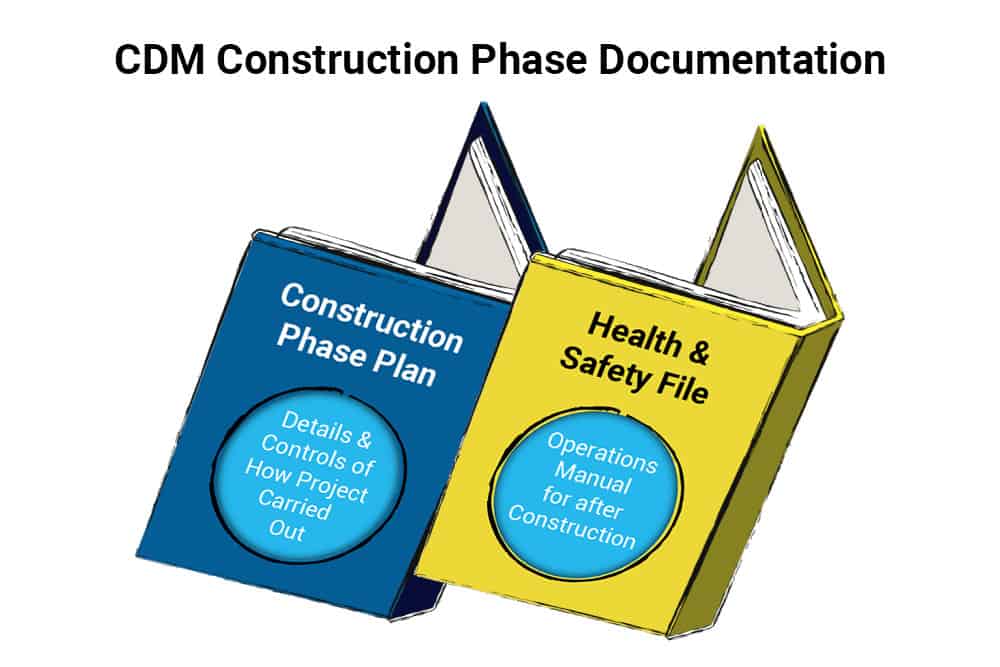
To stay within the legal parameters of the Construction (Design and Management) Regulations (CDM 2015), all building projects must have a written Construction Phase Plan. This applies whether the project is domestic or commercial. It also applies whether the project is notifiable to the Health and Safety Executive (HSE) or not notifiable. The Construction Phase Plan must be drawn up before the work starts, according to the CDM regs. The purpose of the Construction Phase Plan is to control how health and safety will be managed during the Construction Phase.
In this blog post, we will outline the CDM documentation requirements during the Construction Phase of a building project. This includes both the Construction Phase Plan and the Health and Safety File.

The Construction Phase Plan
In our previous blog post, we provided you with detail on what is required in the pre-construction CDM documentation. The next two documents that are required according to CDM Regs are the Construction Phase Plan and the Health and Safety File.
The construction phase must include details such as the planning arrangements, including the site location and any key dates. Health and safety management systems for the construction phase must also be included. For example, how accidents will be reported, and risks assessed.
The health and safety site arrangements should also include site rules, site induction training, and arrangements for specific onsite risks. The Construction Phase Plan does not replace risk assessments and method statements. It is a plan to show how the work will be managed and identifies the significant hazards associated with the work.
The depth of the Construction Phase Plan should reflect the complexity of the work to be completed. A simple plan is required for a simple job, while a more complex project will require a more detailed plan.
The Health And Safety File
The Health And Safety File is a document that is designed to support the future use of the building or structure. It can be thought of as the operator’s manual. The Health And Safety File supports tasks such as:
- Maintenance
- Cleaning
- Refurbishment
- Demolition work
It provides the necessary information to ensure that the work can be carried out without risk to the health and safety of workers. The Health and Safety File should include information such as the location of services, for example, electrical and gas supplies. It must also include architectural plans, operations manuals for fixed plant, and access details. It should also have any relevant health and safety information that would need to be taken into account during any subsequent works.
A health and safety file is only required on projects in which more than one contractor is involved. This applies whether the project is domestic or commercial. The Principal Designer must prepare, review, update, and revise the file as the project progresses.
If the Principal Designer finishes before the end of the project, the file must be passed to the Principal Contractor for the remainder of the project. The Principal Contractor must then take responsibility for reviewing, updating, and revising the file. They must also pass it to the client when the project finishes.
CDM Regs Documentation Overview
We can now refer back to our previous blog on pre-construction documentation and consider how the three main CDM documents fit together.
The pre-construction information comes first and facilitates the production of the Construction Phase Plan. The next document to be referred to is the CDM Construction Phase Plan. As its name suggests, the Construction Phase Plan applies only to the actual building work that is being done.
The Health and Safety File is relevant throughout every stage of the project. This document draws relevant information from both the pre-construction information and the Construction Phase Plan. It gradually becomes more complete as the project progresses.
You can find more detailed information on the CDM regs by downloading the CDM 2015 pdf. If you have any further questions or issues regarding how the CDM regs may apply to your site, please review the information in our other blogs in this series. It may also be helpful to directly contact the HSE themselves for assistance. You can contact the HSE directly via their website or telephone them for assistance.
Where To Learn More About CDM Health And Safety
Under the CDM 2015 regs, a range of documents must be provided to the HSE before any work can start on a construction project. It is therefore vital that all people involved in a building project have a clear understanding of how to prepare these documents.
In recent years, there have been proposed changes to the CDM regs. A range of amendments was set to be introduced in 2020, but this has been pushed back. Please note that at the time of writing, the CDM regulations 2021 have not as yet been enacted into law. This means that all construction work undertaken in the UK must still conform to the CDM 2015 regs. You can download the CDM regulations 2015 pdf from the UK government website for further information.
To ensure that you and your employees have a good understanding of the CDM regs, you can find further training on the Human Focus website. The Human Focus Construction Design Management (CDM) Awareness course is an ideal way to improve your knowledge of how the CDM health and safety regulations are applied.
If you would like to find out exactly how the roles of stakeholders work under CDM regs, CDM Duty Holder Training will provide you with all the information you need.
Both of these Human Focus courses are assured by the Royal Society for the Prevention of Accidents (RoSPA) and can be completed entirely online at your convenience.


















































































































































































































































































































































































































































































































































































































































































































































